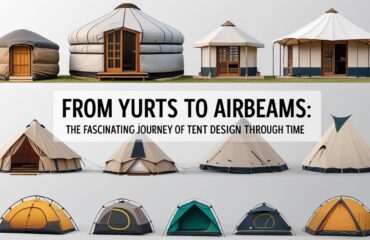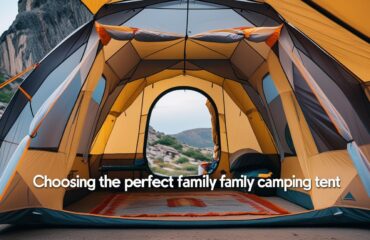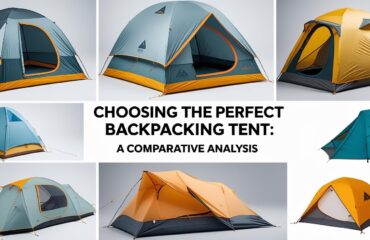Choosing the Right Tent: Pros and Cons of Each Type for Backpacking and Camping

Choosing the right tent is crucial for an enjoyable and safe camping or backpacking experience. The type of tent can significantly impact your comfort, protection from the elements, and overall enjoyment of the outdoors. Different tents are designed for varying purposes, from lightweight options for backpacking to spacious family tents for longer stays. For instance, a backpacking tent like the REI Quarter Dome offers a good balance between weight and livability, making it a popular choice among hikers. Understanding the features and specifications of each type empowers you to make an informed decision that suits your specific needs.
Tents are available in numerous styles, including dome tents, tunnel tents, pop-up tents, and specialized options like bivy sacks and geodesic tents. Each style offers its own set of advantages and disadvantages, impacting factors such as weight, setup ease, durability, and weather resistance. For example, while a dome tent might be lightweight and easy to set up, a family tent may offer more space and comfort but at the cost of portability. Knowing your camping style and preferences will guide you in selecting the best tent for your adventures.
Dome Tents
Dome tents are among the most popular choices for campers, thanks to their lightweight structure and versatility. Typically accommodating anywhere from one to eight people, these tents feature two flexible poles that cross at the center, forming a stable, aerodynamic shape. One notable advantage of dome tents is their ease of setup; they usually require fewer stakes and can be pitched quickly, making them ideal for both novice and experienced campers. For instance, the MSR Hubba Hubba NX is well-regarded for its simple setup and spacious interior, appealing to solo travelers and couples alike.
However, while dome tents provide ample headroom and are generally lightweight, they can be susceptible to high winds due to their shape. Many models come with vestibules, offering additional gear storage outside the main sleeping area. This feature is particularly useful for backpackers who need to keep their gear organized and protected from the weather. Additionally, dome tents often feature robust materials that contribute to their durability, allowing them to withstand moderate weather conditions effectively.
When choosing a dome tent, consider the specific model’s weight and packed size to ensure it fits well within your backpacking gear. Some models even offer features like color-coded poles and clips to streamline the setup process, making them even more user-friendly. Overall, dome tents serve a broad range of camping needs, balancing functionality with ease of use.
Tunnel Tents
Tunnel tents are designed with an elongated shape that allows for a spacious interior and large vestibules for gear storage. They are particularly well-suited for groups or families who prioritize space and privacy. The elongated design also facilitates better airflow and ventilation, which can be a significant advantage during warmer weather, helping to maintain a comfortable sleeping environment. For example, the Terra Nova Laser Compact 2 is a popular tunnel tent known for its stability and generous space for multiple occupants.
On the downside, tunnel tents require careful staking and can sag under heavy rain or snow, which may compromise their durability. They are typically heavier than dome tents, making them less suitable for backpacking trips where weight is a concern. While they may offer more living space, the complexity of setup can deter some campers from choosing this option. It’s essential to practice setting up a tunnel tent before a trip to avoid difficulties in the field.
Despite their drawbacks, tunnel tents often come equipped with multiple entrances, enhancing accessibility and airflow. This feature also allows for better organization of gear, as campers can store their belongings outside the main sleeping area without cluttering the interior. Overall, tunnel tents represent a solid choice for group camping, particularly when comfort and space take precedence over weight considerations.
Pop-Up Tents
Pop-up tents are designed for extreme convenience, allowing for quick setup and takedown, making them ideal for casual camping trips or festivals. Their lightweight nature and pre-attached poles make them a favorite among families looking for a hassle-free experience. An example is the Quechua 2 Seconds Easy Tent, which can be set up in seconds, making it perfect for day trips and short outings. However, despite their ease of use, pop-up tents often lack the durability and weather resistance of other tent types, making them less suitable for extreme conditions.
These tents are best for day trips or quick overnight stays rather than extended camping adventures, as they may not withstand heavy winds or rain. Their lightweight construction can lead to challenges when trying to pack them away after use, with some campers finding it difficult to fold them back into their original carrying case. While they might be convenient for a festival or a day at the beach, investing in a more robust tent would be wise for dedicated camping trips.
Although pop-up tents may be limited in their use, they do offer features like mesh windows for ventilation and rain covers for light showers. They can serve as great temporary shelters during outings, such as family picnics or outdoor events, where quick access to shelter is essential. Overall, while pop-up tents excel in convenience, their functionality is best suited for specific casual environments rather than rigorous camping scenarios.
Backpacking Tents
Backpacking tents are specifically engineered to be lightweight and compact for easy transport on long hikes. Typically designed to accommodate one to two people, these tents prioritize weight over spaciousness, making them essential for backpackers. Many backpacking tents utilize specialized materials that enhance durability while keeping weight to a minimum, which often results in a higher price point. The Big Agnes Copper Spur HV UL is a prime example of a high-quality backpacking tent that balances weight, durability, and livability, making it a top choice among serious hikers.
These tents usually feature a minimalist design that includes a rainfly for additional weather protection, making them versatile across various camping conditions. However, potential buyers should be aware that the focus on lightweight design may lead to sacrificing some comfort and livability features compared to larger family tents. Backpacking tents often come with added features like gear lofts and vestibules to maximize limited space, ensuring that campers can organize their belongings efficiently.
When selecting a backpacking tent, consider the tent’s packed size, weight, and ease of setup to ensure a seamless experience on the trail. Many hikers also appreciate features such as color-coded components that simplify the pitching process, making it easier to set up in various conditions. Ultimately, backpacking tents are an indispensable piece of gear for those who enjoy exploring the great outdoors while minimizing their load.
Family Tents
Family tents, like cabin tents, prioritize spacious interiors with vertical walls to maximize livable space and comfort. These tents can accommodate larger groups and often come with multiple rooms or dividers for increased privacy. For instance, the Coleman Instant Cabin Tent offers ample space and is designed for easy setup, making it a go-to choice for families on camping trips. The generous space is a significant advantage, allowing families to enjoy a comfortable environment with room to move around.
However, family tents are typically heavier and take longer to set up, making them less suitable for backpacking. Due to their size and weight, family tents may require a vehicle for transport, which can limit where they can be used. Many family tents also include features like built-in storage pockets, electrical access ports, and even screened porches, enhancing the camping experience for families who plan to stay in one location for an extended period.
When selecting a family tent, consider factors like the number of occupants, setup time, and the tent’s overall weight. It’s also beneficial to look for models that offer good ventilation and weather protection to ensure a comfortable stay regardless of conditions. While family tents excel in space and comfort, it’s important to balance these features with ease of transport and setup.
4-Season Tents
4-season tents are built to withstand extreme weather conditions, including heavy snow and high winds. These tents are generally heavier and more expensive due to the reinforced materials and construction required for durability. The North Face Mountain 25 is a prime example of a 4-season tent, designed for winter camping and high-altitude expeditions. These tents often come with extra guylines and robust pole systems to ensure stability in harsh conditions, making them ideal for serious adventurers.
Despite their design for extreme weather, 4-season tents can be less ventilated than 3-season tents, making them potentially uncomfortable during warmer months. Some models can be set up without a rainfly, providing flexibility during milder weather. However, the weight and bulk of 4-season tents can be a drawback for those who are not planning to camp in extreme conditions.
When selecting a 4-season tent, consider the terrain and weather conditions you expect to encounter during your trips. Campers should also evaluate the inner space and overall design to ensure that it meets their needs for comfort and livability. Overall, 4-season tents are an excellent investment for those who frequently venture into harsh environments and require reliable protection from the elements.
Geodesic Tents
Geodesic tents are recognized for their exceptional stability due to their complex pole designs, making them a reliable choice for harsh weather. These tents are often heavier and more expensive, which can discourage casual campers from choosing them. However, for serious adventurers facing challenging conditions, models like the REI Geodesic Tent provide unparalleled protection and stability. The intricate design of geodesic tents allows them to distribute wind and snow loads evenly, reducing the risk of collapse.
While they may not be common among casual campers, geodesic tents include features such as multiple entry points and ventilation systems that enhance usability and comfort. Their structure also allows for greater height and living space, offering a more comfortable environment during extended trips. Additionally, the setup process can be more complex than simpler tent designs, requiring some practice to master.
When considering a geodesic tent, it’s important to factor in your camping style and the environments you plan to explore. These tents are typically best suited for experienced campers who prioritize stability and durability in extreme conditions. Overall, geodesic tents are an excellent choice for expedition use and for those who require reliable protection in severe weather.
Bivy Sacks
Bivy sacks are ultra-lightweight and compact, making them a favorite among solo backpackers who prioritize minimizing pack weight. While they offer minimal protection and storage, which can lead to a claustrophobic experience, they are ideal for short trips where weight is a primary concern. An example of a popular bivy sack is the Outdoor Research Helium Bivy, known for its lightweight design and waterproof capabilities, providing essential protection against the elements.
However, bivy sacks are not suitable for long-term camping or for those who enjoy more space. They typically lack features such as ventilation and storage options, leading to a less comfortable camping experience compared to larger tents. Some campers opt to use bivy sacks in combination with a tarp for additional coverage and comfort, especially during inclement weather.
When selecting a bivy sack, consider factors such as weight, packed size, and material durability. It’s also beneficial to evaluate how the sack will perform in various weather conditions, ensuring it provides adequate protection during your adventures. Overall, bivy sacks serve as a fantastic option for minimalist backpackers looking to travel light while still having some protection from the elements.
Choosing the Right Tent
Evaluate essential features like weight, durability, setup ease, and ventilation to match specific camping scenarios. Researching and comparing tent specifications will help ensure that you make an informed purchase decision. For instance, a lightweight tent may be essential for a multi-day backpacking trip, while a family tent might prioritize space and comfort for weekend getaways.
Understanding the trade-offs between weight and comfort is crucial for maximizing your camping experience. Assessing your budget against your desired features can further help narrow down your options effectively, ensuring you find the best tent for your adventures. Taking the time to read reviews and gather feedback from experienced campers can provide valuable insights into how well a tent performs in real-world conditions.
Consider the intended use of the tent and the environments you’ll be camping in, as this will significantly influence your decision. For example, if you plan to camp in areas prone to heavy rain or snow, investing in a more durable, weather-resistant tent is advisable. Ultimately, the right tent can enhance your overall camping experience, offering comfort, protection, and ease of use during your outdoor adventures.




